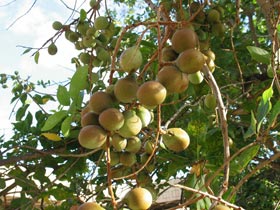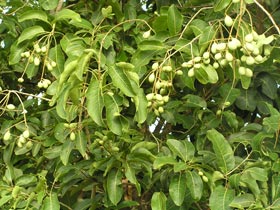Sapindus oahuensis
Genus
Sapindus
Species
oahuensis
Hawaiian Names with Diacritics
- Kaulu
- Lonomea
- Āulu
Hawaiian Names
- Aulu
- Kaulu
- Lonomea
Common Names
- Oʻahu soapberry
- Soapberry
Synonyms
- Sapindus lonomea
Distribution Status
Endemic
Endangered Species Status
No Status
Plant Form / Growth Habit
- Tree
Mature Size, Height (in feet)
- Tree, Medium, 30 to 50
- Tree, Large, Greater than 50
Mature Size, Width
Lonomea has a natural spread of about 40 feet or more.
Life Span
Long lived (Greater than 5 years)
Landscape Uses
- Provides Shade
- Screening
- Specimen Plant
Additional Landscape Use Information
These are very nice additions to a native landscape. Plant with other native plants and shrubs such as ʻaʻaliʻi, ferns and ground covers.
Source of Fragrance
- Fruits
Additional Fragrance Information
The roundish or oval fruits resemble dates, smell like figs or raisins, but are not edible. [Diana Troutman, Native Plants Hawaiʻi]
Plant Produces Flowers
Yes
Flower Type
Not Showy
Flower Colors
- White
Additional Flower Color Information
Lonomea has small whitish flowers.
Blooming Period
- Spring
- Summer
- Winter
Plant texture
- Medium
- Coarse
Additional Plant Texture Information
The leaves range from 3 to more than 10 inches long.
Leaf Colors
- Dark Green
Additional Leaf Color Information
Leaves have a yellow midrib.
Additional Pest & Disease Information
The trees are prone to white flies and small gray weevils. Chinese rose beetles will chew holes in leaves and black twig borers can be a mild to serious problem for lonomea.
Fertilizer
When younger, lonomea appreciate an application of a balanced slow release fertilize with minor elements every six months. Foliar feed monthly with kelp or fish emulsion, or a water-soluble fertilizer with a dilution of one half to one third of recommended strength. [David Eickhoff, Native Plants Hawaiʻi]
Pruning Information
Trim dead material as needed. Fallen fruits and leaves should be raked up in a formal landscape or they can be left as compost in more natural settings.
Water Requirements
- Dry
Additional Water Information
Once established water once a month only the during driest months. A true xeric, or drought tolerant, tree.
Soil must be well drained
Yes
Light Conditions
- Full sun
- Partial sun
Additional Lighting Information
Lonomea tolerates some shade, but require some direct sunlight each day.
Tolerances
- Drought
- Wind
Soils
- Sand
- Cinder
- Coral
Limitations
Lonomea is susceptible to stem rot if over watered.
Natural Range
- Kauaʻi
- Oʻahu
Natural Zones (Elevation in feet, Rainfall in inches)
- 150 to 1000, 0 to 50 (Dry)
- 150 to 1000, 50 to 100 (Mesic)
- 1000 to 1999, 0 to 50 (Dry)
- 1000 to 1999, 50 to 100 (Mesic)
- 2000 to 2999, 0 to 50 (Dry)
- 2000 to 2999, 50 to 100 (Mesic)
Additional Habitat Information
Naturally is found only in mesic to dry forests on northwest Kauaʻi and in the Waiʻanae and Koʻolau Mountains (Waimalu to Niu valleys) on Oʻahu from about 200 to 2,000 feet.
![]() Special Features and Information
Special Features and Information
General Information
Lonomea, or Āulu, (Sapindus oahuensis) belongs to the large international Soapberry family or Sapindaceae. Other well known family members include maple (Acer spp.), horse chestnut, guarana, lychee, longan, and rambutan.
Native members include mānele (Sapindus saponaria), māhoe (Alectryon macrococcus), and ʻaʻaʻliʻ (Dodonaea viscosa).
Etymology
The generic name Sapindus is derived from Latin sapo, or soap, and indicus, Indian. Crushed lonomea fruit makes a sudsy lather when mixed with water and was formerly used as a soap substitute, and thus aptly named the "soapberry tree."
The specific epithet oahuensis is taken from the island of Oʻahu, one of two islands this species is naturally occurring.
Hawaiian Names:
The name Lonomea was used for the trees on Kauaʻi, while Āulu or Kaulu was the name used on Oʻahu by early Hawaiians. But, Lonomea seems to be the general name used throughout the state.
Samuel Lamb notes the additional name Keulu. [4]
Background Information
The hard wood is light brown and apparently similar to mānele (Sapindus saponaria). [7]
Early Hawaiian Use
The very hard blackish seeds were used for medicinal purposes and to string for gorgeous permanent lei. [1,3,5,6]
The hard wood was used to make spears and for other purposes. [8]
Additional References
[1] "Plants in Hawaiian Culture" by Beatrice H. Krauss, page 78.
[2] "Hawaiʻi's Seeds and Seed Leis-An Indentification Guide" by Laurie Shimizu Ide, pages 110-111.
[3] "Hawaiian Seed Lei Making--Step-by-Step Guide" by Laurie Shimizu Ide, page 122.
[4] "Native Trees & Shrubs of the Hawaiian Islands" by Samuel H. Lamb, page 80.
[5] "Nā Lei Makamae--The Treasured Lei" by Marie A. McDonald & Paul R. Weissich, page 5.
[6] "In Gardens of Hawaii" by Marie C. Neal, pages 533-534.
[7] "Common Forest Trees of Hawaii (Native and Introduced)" by Elbert L. Little Jr. and Roger G. Skolmen, page 206.
[8] "Hawaiian Ethnobotany Online Database" http://data.bishopmuseum.org/ethnobotanydb [Accessed 1/24/12]
PHOTOS FOR THIS SPECIES CAN BE SEEN AT THE LINK (Copy & Paste to your browser):
https://www.flickr.com/search/?user_id=50823119%40N08&sort=date-taken-desc&view_all=1&text=Sapindus%20oahuensis
Plant Gallery
Back to Plant List
Other Nursery Profiles for Sapindus oahuensis



